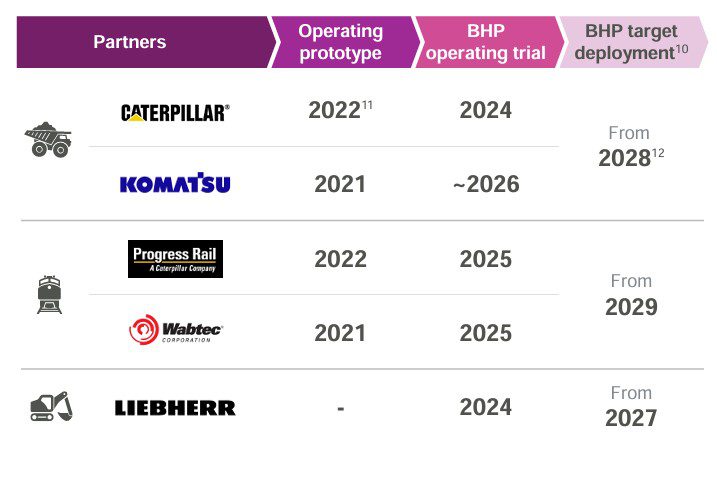Australian mining giant BHP says it will delay the electrification of its fleet of massive mining vehicles due to what it describes as the slowing in development of some “decarbonisation technology”.
Hidden away in the middle of the company’s full year financial results presentation and speech held on Tuesday, chief financial officer Vandita Pant confirmed that BHP would delay its “previously anticipated spend on operational decarbonisation” into “the 2030s”.
BHP has targeted a reduction in its operational emissions by at least 30 per cent by financial year (FY) 2030 based on FY2020 levels, on its way to an “aspirational” goal of net zero operational emissions by 2050.
While Pant maintained that BHP remains “on track” to meet its “2030 target for operational greenhouse gas emissions”, this delay to further electrification and “diesel displacement” is being blamed on what Pant describes as the slowing in the pace of development of some decarbonisation technology”.
“We expect our previously anticipated spend on operational decarbonisation to now be in the 2030s, aligned with the delayed timeline for critical technologies to become commercially available,” he said in the results presentation.
The decision by BHP to effectively delay around $1 billion in capex spending is in stark contrast to Fortescue Metals, which is aiming to reach “real zero” at its Pilbara iron ore mines by the end of the decade, which would mean not burning fossil fuels for any land transport of mining activity by that time.
Fortescue is spending more than $4 billion on a fleet of giant haul trucks and other mining equipment such as electric excavators. It is investing in new drivetrain, battery and EV charging technologies to help meet its target.
BHP’s operational decarbonisation plans are fleshed out in greater detail in a recently updated disclosure on the company’s website which outlines the actions the company is taking to meet its 2030 goal.
In addition to procuring renewable electricity to power site operations and “minimising” the growth of operational emissions from natural growth and expansion, BHP again refers to “diesel displacement” as its shorthand for the electrification of its fleet of “materials movement” vehicles.
However, instead of the more optimistic proposals published in previous years’ decarbonisation presentations, BHP now says only that it is “working towards a reduction in risk exposure to diesel displacement solutions.”
This includes “testing, piloting and de-risking battery-electric haul truck technology, battery-electric locomotives, and the electrification of excavators and other diesel equipment.”
This contrasts strikingly with BHP’s own proposed rollout of diesel displacement technologies from its 2024 ‘Decarbonisation: Strategy and progress’ investor presentation published in June of 2024.

The idea that the development of diesel displacement technology such as battery electric trucks and locomotives has slowed and must first be ‘de-risked’ and tests and pilots extended into the next decade therefore comes as something of a surprise, not only when tested against BHP’s own expectations of a year ago, but also of local competitors.
Fortescue has already been trialling a 240-tonne battery electric haul truck prototype known as Roadrunner and announced last year that it would invest $4 billion to purchase hundreds of such electric haul trucks as well as electric dozers and excavators.
Supporting these battery electric vehicles will be a 6-megawatt (MW) fast charger developed by Fortescue which will be used to charge the 1.9 megawatt-hour (MWh) batteries necessary to power the trucks.
These vehicles are more than just a dream, with an electric excavator going into operation at Fortescue Metals Cloudbreak iron ore mine site in the Pilbara back in late 2023 and quickly hitting a significant milestone of moving one million tonnes.
Earlier this year, Fortescue Metals put down another $350 million to buy more than 50 autonomous electric drill rigs to replace existing diesel-powered machines. And in June, Fortescue took delivery of its first battery electric locomotive prototype.
Fortescue has also developed the Green Pioneer, the world’s first green ammonia dual-powered vessel which will be used to transport iron ore around the globe, and which has already completed a number of sea trials.
Joshua S. Hill is a Melbourne-based journalist who has been writing about climate change, clean technology, and electric vehicles for over 15 years. He has been reporting on electric vehicles and clean technologies for Renew Economy and The Driven since 2012. His preferred mode of transport is his feet.


